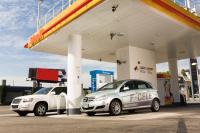Shell Opens Third Hydrogen Station in Southern California
Shell announced the opening of a new demonstration hydrogen station in Torrance, California, the first in the US to have hydrogen delivered to the site directly from an existing underground pipeline. Excess hydrogen is typically available on the hydrogen pipelines used by oil refiners. Hydrogen is used to provide cleaner gasoline and diesel. Although hydrogen is most often reformed from natural gas, it is also available from the electrolysis of water wastewater treatment byproduct, and chemical plant byproduct.
Southern California has been the center for test deployment of hydrogen fuel cell cars. The West Coast has been the area of greatest use of hydrogen fuel cell buses, including the 20 hydrogen buses in Whistler, Canada that transported about 100,000 visitors during the last Winter Olympics.
Hydrogen fuel cell cars provide a way to give an electric car a range of up to 400 miles with hydrogen PEM fuel cells that supply added electricity to an electric drive system. GM successfully piloted 100 Equinox fuel cell vehicles during its Project Driveway. Toyota is planning to test 100 new fuel cell SUVs as it prepares for 2015 commercialization. Toyota FCHV Test Drive. 200 of the new Mercedes-Benz B-Call F-CELL are being put into use. Several automakers are targeting 2015 for the commercialization of fuel cell vehicles.
50,000 Commercial Hydrogen Cars by 2017 from Toyota, Honda, GM, Mercedes
Between 2008 and 2010, the fuel cell industry experienced a compound annual growth rate (CAGR) of 27% according to the new Fuel Cells Annual Report 2011 from Pike Research. The California Fuel Cell Partnership forecasts over 50,000 hydrogen vehicles on California roads by 2017.
“Shell is pleased to be an active participant in the development of hydrogen-fuelled transportation, one of a small number of options to reduce road transport emissions in the longer-term,” said Julian Evison, General Manager of Operations for Shell Alternative Energies. “Demonstration hydrogen filling stations allow us to evaluate a range of different technologies and learn valuable lessons about costs, consumer behavior, how to safely store hydrogen at different pressures and how to dispense it efficiently to different vehicles.’’
Initially, Shell expects 10 to 12 drivers to fill their tanks each day at the Torrance station’s two pumps, which provide hydrogen at both 350 bar (5,000 psi) and 700 bar (10,000 psi) pressure. Current fueling capacity is 48 kg. of hydrogen per day, equivalent to dispensing 48 gallons of gasoline. To exceed 200 mile range, most new fuel cell cars require 10,000 psi. Honda is the sole achiever of long-range at 5,000 psi with the Honda FCX Clarity. Only a handful of California stations support the high pressure fueling.
The close proximity of the hydrogen pipeline to TMS campus led Toyota to think beyond vehicles to consider additional ways to use hydrogen. In 2010, Toyota partnered with Ballard Power Systems to install a one-megawatt hydrogen fuel cell generator to offset peak electricity demand on campus. The fuel cell generator will be fed directly from the hydrogen pipeline through an existing tap on the TMS property. Pipeline hydrogen used on campus will be offset with the purchase of landfill generated renewable bio-gas.
The stand-alone station in Torrance offers only hydrogen and will be open 24 hours a day. Local fuel cell vehicle drivers will be trained to use the dispensers using personal access codes. The station is located on land provided by Toyota at the perimeter of its US headquarters.
Shell Delivers Hydrogen 24×7
“Vehicle demonstration programs and demonstration stations like the Torrance station are a critical next step in preparing the market for advanced technology vehicles,” said Chris Hostetter, Toyota GVP of Product and Strategic Planning. This is the third demonstration station Shell has developed in the region. Shell opened the first integrated gasoline/hydrogen station in California in 2008 (in West L.A.) and a smaller sister station in Culver City in 2009. Shell is planning on building a hydrogen refueling site at one of its gas stations in Newport Beach later this year.
The station has been anticipated for years due to the potential of pipelined hydrogen to be less expensive than gasoline. It is now open after years of delay thanks to support from Toyota and Shell, who were not initial project partners. The much touted California Hydrogen Highway was never funded.
In addition to Shell Hydrogen and Toyota, project partners for the Torrance hydrogen demo station include Air Products, the US Department of Energy and the South Coast Air Quality Management District.


A couple of questions.
1-What is the cost per mile comparison to gasoline? To solar?
Can a consumer own their own source of hydrogen fuel production (like rooftop solar), or would they need to rely on another corporate monopoly?
Haven’t the oil companies teamed up with the auto industry in the past to try and kill the electric car? Is this another attempt?
Little hydrogen is provided by oil companies. They see it as competition, but Shell is wise to diversify from just betting on fossil fuels. Yes, oil companies see electric drive systems from battery-electric to plug-in hybrid to hydrogen fuel cell as a major threat.
Solar is frequently used when hydrogen is made by electrolysis. AC Transit uses 600kW of Sun Power for balance of systems in its onsite reformation of natural gas as they have increased from 3 to 12 buses: https://cleanfleetreport.com//fleets/electric-buses/
Hydrogen is usually 2X to 3X the price of gasoline, but it is used with 80% efficient electric drive systems, rather than 15 to 20% efficient engines.